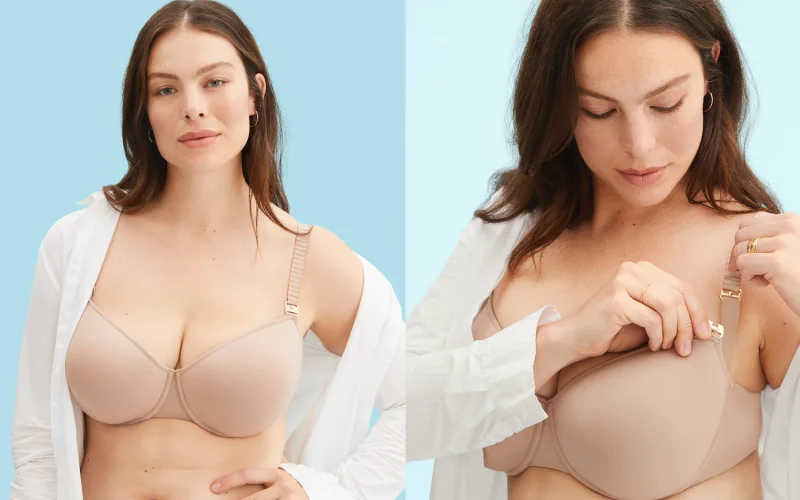Are you expecting or nursing and looking for the perfect bra to support you through this beautiful journey? Maternity and nursing bras are essential for providing comfort and support during pregnancy and breastfeeding.
As your body undergoes significant changes, it’s important to understand the key differences between maternity and nursing bras and why it matters.
Pregnancy brings about various changes in a woman’s body, especially in the breast area.
Understanding these changes is crucial in finding the right bra to support these transitions.
Maternity and nursing bras serve different purposes, and knowing the distinctions between the two is essential for your comfort and well-being.
This article will delve into the differences between maternity and nursing bras, the importance of comfort and support, and how to find the perfect fit for your changing body.
We will also explore the features and functionality of these bras and tips for maintaining comfort and functionality throughout your pregnancy and breastfeeding journey.
Whether you’re a soon-to-be mom or a nursing mother, finding the right bra is crucial, and we’re here to guide you through this process.
Understanding Breast Changes During Pregnancy

Pregnancy heralds significantly changes a woman’s body, particularly in breast tissue.
Due to rising pregnancy hormones, the expansion of milk ducts commences, often increasing breast size.
For some, this phenomenon might manifest as early as the sixth week of pregnancy, while others may notice growth further along during the third trimester.
It’s crucial to consider appropriate undergarments during this period.
Traditional bras with underwires and rigid cups can impede this natural expansion, risking blocked ducts and the painful condition known as mastitis.
Consequently, choosing bras that cater to these morphological changes becomes essential, ensuring gentle support without constriction.
Regular fittings are suggested to accommodate fluctuating breast sizes, as the breasts are in constant flux throughout pregnancy.
Nursing bra cups should permit ample room for the breasts to swell post-birth, coinciding with milk production.
An optimal nursing bra combines ease of breastfeeding functionality with unwavering support, having features like nursing clips for convenience.
Meanwhile, maternity bras should prioritize comfort, with stretchy fabric and wider straps to shoulder the additional weight without digging into the skin.
Remember, a comfortable and supportive bra is not a luxury but a necessity to navigate the changes the body undergoes during pregnancy.
Maternity Bras vs. Nursing Bras
Maternity and nursing bras might initially appear similar, but they serve unique functions at different stages during and after pregnancy.
The principal distinction lies in their design and the specific needs they address relative to a woman’s body during pregnancy.
Maternity bras are crafted to support the breasts during pregnancy.
They typically feature stretchy fabric that accommodates the breast growth that many women experience.
With adjustable straps and extra hook-n-eye closures, these bras can expand to fit the rib cage, and breast size tends to increase as weeks of pregnancy progress.
The cups are designed to adapt to the changing breast tissue without compressing the milk ducts, promoting comfort and preventing complications like mastitis.
On the other hand, nursing bras are all about facilitating breastfeeding once the baby arrives.
These bras maintain the comfort attributes of maternity bras, including stretchy fabric and adjustable straps, but they also include practical features for nursing mothers.
For instance, nursing bras are equipped with nursing clips that allow the cups to be opened with one hand, giving easy access to the nipples for breastfeeding.
These cups can also accommodate breast pads to catch any leakage, a common occurrence in the weeks of breastfeeding.
Reflecting on the design differences, maternity bras are predominantly focused on providing a comfortable fit and ample support during breast growth.
In contrast, nursing bras are tailored to support postpartum breast changes with added breastfeeding functionality.
Key Differences and Features
When shopping for pregnancy and postpartum bras, it’s helpful to understand the key differences and features that set maternity and nursing bras apart.
- Maternity Bras
- Stretchy Fabric: To accommodate continuous breast growth throughout the months of pregnancy.
- Wider and Adjustable Straps: To shoulder the additional weight and changing band sizes.
- Extra Hook-n-Eye Closures: These accommodate an expanding rib cage during pregnancy.
- Breathable Fabrics: To maintain comfort and minimize skin irritation as body temperature may rise during pregnancy.
- Nursing Bras
- Nursing Clips or Panels: For quick and easy access to breastfeeding.
- Space for Breast Pads: To contain leaks and maintain dryness and hygiene.
- Supportive Nursing Bra Design: The bra should still support the breast even with the flap down.
- Seamless Nursing Bra Options: To offer comfort and be less visible under clothing.
A table outlining the differences between the two types of bras could also assist in distinguishing their features at a glance:
| Feature | Maternity Bras | Nursing Bras |
|---|---|---|
| Adjustable Straps | Yes | Yes |
| Stretchy Fabric | Yes | Yes |
| Breast Growth Accommodation | Yes | Less so |
| Easy Breastfeeding Access | No | Yes |
| Breast Pad Space | No | Yes |
| Extra Closures for Rib Cage | Yes | Not always |
Importance of Comfort and Support
During pregnancy, a woman’s body changes profoundly, putting new demands on her clothing, especially her bras.
The significance of comfortable maternity and supportive nursing bras cannot be overstated.
Comfort is paramount as the breasts become more tender and sensitive during weeks of pregnancy.
The added breast growth and weight gain mean that the breasts require more support to alleviate stress on the back and shoulders.
Wider straps and soft, Breathable fabrics contribute to making a comfortable maternity bra that reduces the risk of discomfort and skin irritation.
Post-pregnancy, a supportive nursing bra becomes essential.
This type of bra must be supportive enough to handle increased breast size due to milk supply yet flexible enough to adjust to the fluctuating size as the breasts fill and empty with milk.
A good nursing bra also includes features such as nursing clips for easy breastfeeding, ensuring a mother can feed her baby without hassle.
To sum up, comfort and support in maternity and nursing bras are indispensable not only for the health and well-being of the mother but also for a smooth breastfeeding experience.
You should have at least four maternity bras for different uses and at least one seamless nursing bra, which provides various options to suit different outfits and occasions.
Finding the Right Fit

Finding the right fit in a maternity or nursing bra is not just about comfort—it’s a crucial aspect of maternal health.
With the potential risk of plugged ducts, mastitis, and soreness, a bra with a fit that’s too tight can contribute to complications.
The key to avoiding such issues is ensuring the band is snug but not constricting, allowing for the natural adjustments in breast size associated with milk production and breastfeeding.
The most reliable method for finding your bra size is visiting a lingerie store and obtaining a professional fitting.
A seasoned salesperson will measure your bust and underbust to determine your ideal size.
While some online bra retailers offer instructions for self-measurement, experts strongly advise purchasing at least one bra in person to secure an impeccable fit before opting for online shopping.
This hands-on approach to bra fitting significantly reduces the guesswork and aids in selecting a nursing bra that’s not too small, avoiding unwelcome pressure on the milk ducts and associated health concerns.
Band Sizes and Understanding Rib Cage Changes
An expanding rib cage is one of the key changes your body undergoes during pregnancy as it makes room for your growing baby.
This modification often increases band size, underscoring the importance of supportive nursing bras.
A woman’s band size may fluctuate throughout her pregnancy and breastfeeding journey, necessitating several bra sizes to address the changes.
Measuring your rib cage is essential to find the correct band size for maternity and nursing bras.
Use a sizing chart to translate this measurement into the appropriate band size, ensuring you receive the support and comfort required during these transformative times.
Understanding the dynamics of rib cage expansion is critical when selecting band sizes for maternity and nursing bras to promote a comfortable and supportive fit.
Cup Sizes and Breast Tissue Changes

During pregnancy, women often experience changes in their breast tissue, with some noticing an increase in cup size by 2 to 3 sizes or more.
To accommodate this change, maternity bras are constructed with stretchy fabrics and adjustable features, allowing for the natural evolution of breast size as pregnancy progresses.
It may be necessary to go bra shopping more than once during pregnancy, as your cup size may continue to grow or shift at different stages.
While designed for postpartum breastfeeding functionality, nursing bras can also be worn during the last trimester to accommodate the late-pregnancy fluctuations in breast size.
Comfort is emphasized in maternity bras, and a supportive band is vital in accommodating the increased breast size.
The Role of Adjustable and Wider Straps
Adjustable and wider straps play a pivotal role in the design of maternity and nursing bras.
They are engineered to evenly distribute the weight of larger, more sensitive breasts during pregnancy and breastfeeding.
These expanded straps offer exemplary support, helping to prevent strain on the shoulders and reduce the risk of discomfort.
A maternity bra featuring straps that can be adjusted ensures that it can adapt to the changing size of the breasts throughout pregnancy.
Likewise, this adjustability in nursing bras can help mitigate issues like stretch marks and alleviate the back and shoulder pain often associated with the increased bust size.
In summary, the versatile straps featured in maternity and nursing bras are fundamental for providing a comfortable, supportive fit as the body undergoes various changes during pregnancy and breastfeeding.
Features and Functionality
When designing maternity and nursing bras, manufacturers prioritize features and functionality that cater to the specific needs of pregnant and breastfeeding women.
Like those from PrimaDonna, a well-made nursing bra incorporates soft, padded cups that comfort and enhance the breast silhouette.
These nursing bras are crafted with lightweight, flexible fabrics that seamlessly adapt to your changing shape.
These bras are essential in reducing skin irritation and providing gentle support throughout the day.
PrimaDonna’s underwire nursing bras are specifically engineered to maintain structure and offer ample support, critical during pregnancy and postpartum.
The strategically placed padding provides more than just comfort; it also offers an attractive contour to your breasts, boosting your confidence.
Moreover, PrimaDonna’s collection of nursing bras caters to various needs, ensuring that every woman can find the perfect fit for safety, support, and comfort during this special chapter of her life.
Nursing Clips and Breastfeeding Accessibility
Nursing bras outshine typical bras by featuring unique clips, clasps, zips, panels, or buttons designed to grant easy breast access for feeding.
For instance, PrimaDonna’s nursing bras include clips enabling mothers to feed their babies without removing the bra or arm from the straps.
This feature is particularly convenient for breastfeeding on the go, as one-handed, fuss-free maternity clips can save time and effort.
Furthermore, some nursing bras come with a built-in sling that provides additional support during feeding, ensuring that the breast is well-supported and the process is as seamless as possible.
Breathable Fabrics and Seamless Design
The selection of breathable fabrics, such as cotton and silk, is considerable for maternity and nursing bras.
These materials help keep women cooler and more comfortable, which is vital during pregnancy and breastfeeding when increased sensitivity and tenderness can cause discomfort.
Breathable fabrics efficiently minimize itchiness and sweatiness, enhancing overall comfort.
Seamless maternity and nursing bra designs, like the Body Silk Seamless bra, boast a stretchy, adjustable fit to accommodate fluctuating breast sizes.
The Original Nursing Bra, fashioned from a cotton-modal blend, provides light to medium support for tender breasts. It is suitable for daily wear and nighttime use.
Choosing a bra that combines seamless construction with breathable fabric can significantly lessen stress, pain, and discomfort for women throughout pregnancy and postpartum.
Supportive Features for Changing Breast Size
Maternity bras are designed with stretchability in mind, particularly in the cups, to allow for the natural changes in breast size during pregnancy and breastfeeding.
A supportive band is pivotal in a maternity bra’s design, providing the most support.
The band should fit snugly yet comfortably, adapting to the body’s changes, such as the expanding rib cage during pregnancy.
Adjustability in the band is essential for daytime wear to accommodate growth, while bras intended for nightwear preferably lack hooks and eyes for added comfort.
In addition, nursing bras are fashioned with convenience in mind, featuring easy drop-down cup clips for feeding.
Some models also include a built-in sling to ensure the breast remains well-supported during breastfeeding.
These thoughtful features epitomize the marriage of innovation and functionality necessary for maternity and nursing bras to effectively serve mothers.
Maintaining Comfort and Functionality
Regarding maternity and nursing bras, the ultimate goals are comfort and functionality.
These are essential not just during the months of pregnancy but also throughout the weeks of breastfeeding.
Both maternity and nursing bras offer key design features to maintain comfort and support as the body changes.
Maternity bras, designed for wear during pregnancy, accommodate the increased breast size and sensitivity as milk ducts prepare for breastfeeding.
They often feature wider straps and bands to support the growing weight of the breasts and stretchy fabric to adapt to the expanding rib cage and breast growth.
These bras typically lack the breastfeeding functionality of nursing bras but provide superior comfort during pregnancy.
Conversely, nursing bras are made for postpartum wear and essential for the following months of breastfeeding.
They come with nursing clips for easy one-handed release, allowing for convenient breastfeeding or pumping.
Again, the straps are wider, adjustable for support, and often seamless to prevent irritation on sensitive skin.
Using Breast Pads and Understanding Milk Supply
Breast pads are necessary for nursing mothers to absorb milk leaks between feedings.
These pads can be nestled comfortably inside maternity and nursing bras and are crucial for maintaining hygiene and preventing wet stains on clothing.
Understanding your milk supply patterns can inform how often you change the pads to stay comfortable and dry.
It’s highly recommended to use breast pads, especially early in the breastfeeding journey when milk supply can be unpredictable.
Some maternity and nursing bras have pockets to hold the pads, ensuring they don’t shift and cause discomfort or leakage.
For nighttime, many mothers prefer to insert them into softer crop tops that offer gentle support while they sleep.
The Importance of Comfortable and Stretchy Fabric
The significance of comfortable, stretchy fabric in maternity and nursing bras cannot be understated.
These materials provide 360-degree medium support and can stretch to accommodate the varying breast sizes women experience throughout the day.
Quality bras often feature a four-way stretch fabric, guaranteeing a smooth and snug fit without cutting into the skin or causing discomfort.
The seamless design of these bras reduces the risk of irritation, while the breathable, soft fabric enhances comfort.
This is especially important for expectant and new mothers, as their bodies continuously adapt and require apparel that can adjust accordingly.
The result supports changing breast size, shape, and discretion for the nipple area.
Finding the Right Bra for Your Changing Body
Finding the right fitting maternity or nursing bra is paramount to preventing issues like plugged milk ducts or sore breasts.
Getting fitted in person at a specialty store is recommended, as a professional fitting can help ensure the band isn’t too tight and the cups are the right size.
Additionally, many mothers prefer bras that can be operated with one hand since they may often hold their baby with the other.
Different bras are designed for different purposes, so it’s vital to consider your daily activities—sleeping, exercising, working, and casual wear.
Having multiple bras to accommodate these activities is recommended, ensuring you always have the proper support.
Key considerations include comfort, convenience, and whether the bra can accommodate breast pads, is structured or soft, and provides shaping and support.
When bra shopping for your changing body, it is advisable to visit a maternity store rather than mainstream retailers.
They are more likely to carry a wider selection of sizes and styles tailored to pregnancy and postpartum needs.
Try on various styles, read sizing charts carefully, and test different options at home to find the best fit during pregnancy and breastfeeding.








